Discover the History of Nikko: A Walking Tour
Embark on a special self-guided walking tour through the historic city of Nikko, tracing the footsteps of Tokugawa Ieyasu. This tour takes you through significant sites associated with the founder of the Edo Shogunate, including the UNESCO-listed Nikko Toshogu Shrine and other sacred temples and shrines.
Your journey begins at Tobu Nikko Station and leads you to the magnificent Nikko Toshogu Shrine, where Tokugawa Ieyasu is enshrined. Along the way, you will explore various historical landmarks before returning to Tobu Nikko Station. Immerse yourself in the seasonal beauty of Nikko while reflecting on the legacy of Tokugawa Ieyasu and the grandeur of the Edo Shogunate.
- Tour Overview
- Route Details
- 1️⃣ Tobu Nikko Station – Starting Point
- 2️⃣ Statue of Tenkai – A Revered Monk of the Tokugawa Clan
- 3️⃣ Treasure House – A Collection of Historical Artifacts
- 4️⃣ Ichi-no-Torii – The Official Entrance to Nikko Toshogu Shrine
- 5️⃣ Five-Story Pagoda – A Symbol of Architectural Brilliance
- 6️⃣ Omote-mon – The Majestic Main Gate of Toshogu Shrine
- 7️⃣ Three Wise Monkeys – The Famous “See No Evil, Hear No Evil, Speak No Evil” Carvings
- 8️⃣ Yomei-mon – The Lavish Symbol of Toshogu Shrine
- 9️⃣ Nemuri-neko (Sleeping Cat) – A Symbol of Peace
- Okumiya Hōtō – The Sacred Mausoleum of Tokugawa Ieyasu
- 1️⃣1️⃣ Nikkō Tōshōgū Shrine – Honden & Haiden
- 1️⃣2️⃣ Rinnoji Yakushido – The Temple of the Healing Buddha
- 1️⃣3️⃣ Rinnoji Taiyuin – The Mausoleum of Tokugawa Iemitsu
- 1️⃣4️⃣ Kyūokusha Karamon & Kyūokusha Torii – Ancient Remnants of Toshogu’s Predecessor
- Final Destination: Tobu Nikko Station
- Route Map
- Google Map
- Return to the Tokugawa Ieyasu page
Tour Overview
This historical walking tour starts at Tobu Nikko Station and takes you through sites related to Nikko Toshogu Shrine. Highlights include the solemn Okumiya Hōtō, the symbolic Nemuri-neko (Sleeping Cat), the majestic Five-Story Pagoda, and the Rinnoji Taiyuin, the mausoleum of Tokugawa Iemitsu. You will also pass through the Ichi-no-Torii gate, admire the Omote-mon gate, and visit the Treasure House, which houses valuable cultural artifacts. The tour also includes lesser-known historical sites like the Kyūokusha Karamon & Kyūokusha Torii. Following the footsteps of the shogun, you will travel on foot from Tobu Nikko Station through landmarks that bridge the Sengoku and Edo periods.
- Goal: Tobu Nikko Station
- Duration: Approximately 3–4 hours (including walking and sightseeing)
Route Details
1️⃣ Tobu Nikko Station – Starting Point
Address: 4-3 Matsubaracho, Nikko, Tochigi 321-1406
Walking Time to Next Stop: 23 minutes
Access:
- From Tokyo Station: Approx. 2 hours 50 minutes
- Tokyo Station → Asakusa Station (JR and Tokyo Metro)
- Asakusa Station → Tobu Nikko Station (Tobu Railway Limited Express)
- From Haneda Airport: Approx. 3 hours
- Haneda Airport Terminal 1 & 2 → Keikyu Kamata → Shinagawa → Sengakuji → Asakusa Station (Keikyu Line & Toei Asakusa Line direct service)
- Asakusa Station → Tobu Nikko Station (Tobu Railway Limited Express)
Why Start Here?
Tobu Nikko Station is the main gateway for travelers coming from Tokyo. It is conveniently located near tourist information centers and bus stops.
2️⃣ Statue of Tenkai – A Revered Monk of the Tokugawa Clan
Overview
Tenkai was a renowned Buddhist monk who served as a close advisor to Tokugawa Ieyasu and played a significant role in shaping the religious policies of the Edo shogunate and the development of Nikko Toshogu Shrine. A monk from Enryaku-ji Temple on Mount Hiei, Tenkai helped establish Nikko as a northern spiritual stronghold after Ieyasu’s passing and contributed to the creation of Toshogu Shrine.
The Statue of Tenkai was erected in Nikko to honor his achievements. Even after his death, Tenkai’s influence remained profound, and his philosophy of “Tosho Daigongen” became a spiritual pillar supporting the Tokugawa family’s authority.
Address: Kamihatsuishi-machi, Nikko, Tochigi 321-1401
Walking Time from Tobu Nikko Station: 23 minutes (1.5 km)
⏳ Suggested Visit Time: 5 minutes
Highlights:
- Tenkai (1536–1643) was an influential monk who served Tokugawa Ieyasu and played a key role in the creation of Nikko Toshogu Shrine.
- Several temples in the area are dedicated to Tenkai.
- The statue stands in a serene setting, capturing the solemn atmosphere of Nikko.
3️⃣ Treasure House – A Collection of Historical Artifacts
Overview
The Treasure House is a facility that showcases valuable cultural assets and historical materials related to Nikko Toshogu Shrine. Visitors can view important artifacts such as weapons, letters, and crafts associated with Tokugawa Ieyasu. The current Treasure House building was constructed in 1964. Inside, visitors can learn about the history of Nikko Toshogu, its architectural features, and the intricate decorations adorning the shrine buildings. A visit to the Treasure House alongside a shrine tour offers a deeper understanding of the site’s significance.
Address: 2301 Yamanouchi, Nikko, Tochigi 321-1431
Walking Time from Statue of Tenkai: 10 minutes (700m)
⏳ Suggested Visit Time: 25 minutes
Highlights:
- Displays historical artifacts related to Nikko Toshogu Shrine, including samurai armor and ancient texts.
- A great place to deepen your understanding of the Tokugawa Shogunate.
4️⃣ Ichi-no-Torii – The Official Entrance to Nikko Toshogu Shrine
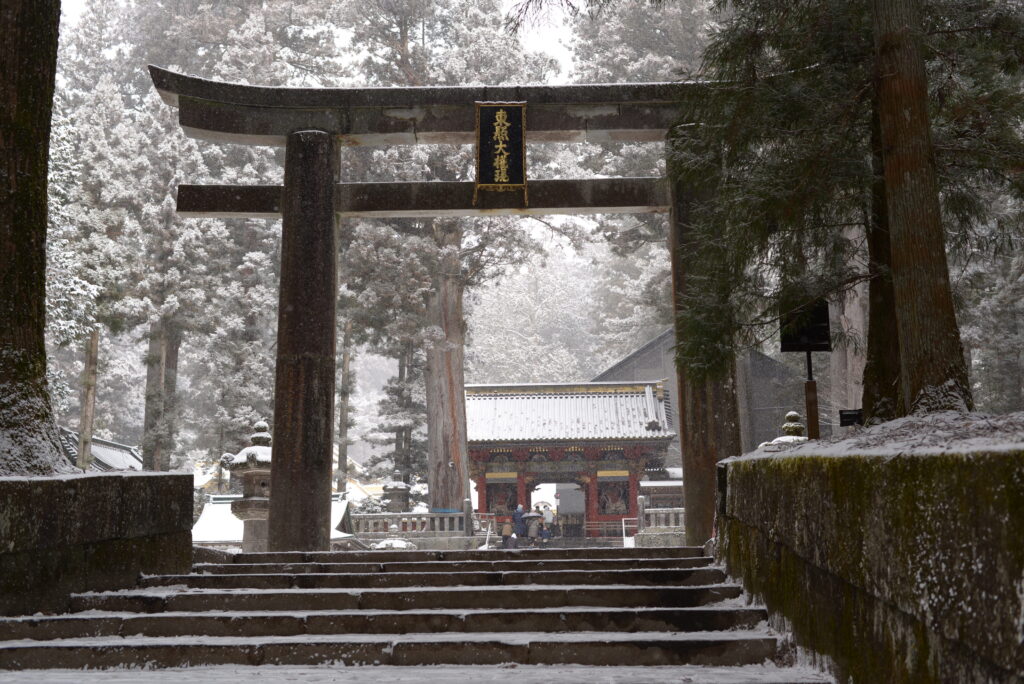
Overview
Ichi-no-Torii is a massive stone torii gate that marks the official entrance to Nikko Toshogu Shrine. As a symbolic gateway, it represents the transition from the secular world to the sacred realm.
This torii was donated in 1633 by Maeda Toshitsune, the lord of the Kaga domain. Made of granite, it is known as one of the largest stone torii gates in the Kanto region. At its center, a plaque inscribed with “Toshogu” welcomes visitors as they step into the shrine’s sacred grounds.
| Item | Content |
|---|---|
| Year Built | 1618 (Keichō 23) |
| Builder | Kuroda Nagamasa, Lord of Chikuzen Domain (present-day Fukuoka Prefecture) |
| Structure/Features | 9.2-meter-tall stone torii constructed from 15 granite blocks; designed with hollowed top beams (kasagi and shimaki) to reduce weight and enhance earthquake resistance |
| Renovation/Restoration | None; remains in its original form since construction |
| Current Status | Standing; designated as an Important Cultural Property of Japan |
| Destruction/Damage | None |
| Cultural Property Designation | Important Cultural Property of Japan |
| Remarks | – |
Address: 2281-3 Yamanouchi, Nikko, Tochigi 321-1431
Walking Time from Treasure House: 2 minutes (100m)
⏳ Suggested Visit Time: 5 minutes
Highlights:
- A massive stone torii gate marking the beginning of the sacred grounds.
- Serves as a transition from the everyday world to the spiritual realm of Toshogu Shrine.
5️⃣ Five-Story Pagoda – A Symbol of Architectural Brilliance
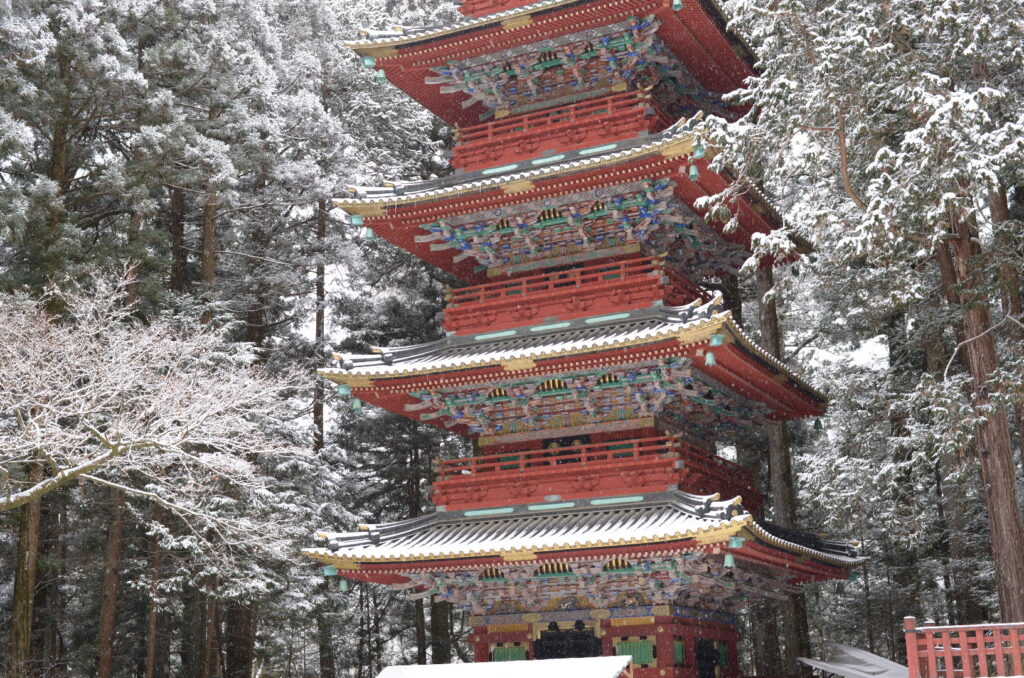
Overview
Five-Story Pagoda Standing approximately 36 meters tall near the entrance of Nikko Toshogu Shrine, the Five-Story Pagoda is a striking structure that greets visitors. The original pagoda was donated in 1634 by Kato Akinari, the lord of the Aizu domain, but it was destroyed by fire in 1827. The current pagoda was reconstructed in 1831.
Each tier of the pagoda symbolizes one of the five elements of Buddhist cosmology: earth, water, fire, wind, and void. Inside, the pagoda features a unique seismic-resistant design, with a central pillar (shinbashira) that is not fixed to the ground but rather suspended, showcasing traditional Japanese earthquake-resistant architecture.
| Item | Content |
|---|---|
| Year Built | 1818 (Bunsei 1) |
| Builder | Sakai Tadayuki, 10th Daimyō of Obama Domain |
| Structure/Features | Five-story pagoda with a suspended central pillar (shinbashira); each tier represents one of the five elements: earth, water, fire, wind, and void |
| Renovation/Restoration | Rebuilt in 1818 after the original pagoda, constructed in 1650 by Sakai Tadakatsu, was destroyed by fire in 1815 |
| Current Status | Standing; designated as an Important Cultural Property of Japan |
| Destruction/Damage | Original pagoda destroyed by fire in 1815 |
| Cultural Property Designation | Important Cultural Property of Japan |
| Remarks | – |
Address: 2301 Yamanouchi, Nikko, Tochigi 321-1431
Walking Time from Ichi-no-Torii: 1 minute (10m)
⏳ Suggested Visit Time: 10 minutes
Highlights:
- Originally built in 1650 and reconstructed in 1818, standing at 36m tall.
- Features intricate carvings representing the twelve zodiac signs.
- Entrance to the interior is available during special exhibitions.
6️⃣ Omote-mon – The Majestic Main Gate of Toshogu Shrine

Overview
Omote-mon serves as the main entrance to Nikko Toshogu Shrine and is the first significant gate visitors pass through on their way to the sacred precincts. Also known as “Niomon,” the gate houses two imposing Kongorikishi guardian statues that ward off evil spirits.
The current Omote-mon was constructed during the major renovations of 1636 and holds great historical value. Beyond this gate lies the magnificent Yomei-mon, further enhancing the grandeur of the shrine.
| Item | Content |
|---|---|
| Year Built | 1636 (Kan’ei 13) |
| Builder | Tokugawa Iemitsu |
| Structure/Features | Red-painted gate measuring 8.3 meters wide and 4.3 meters deep, adorned with 82 carvings of imaginary animals and flowers; guarded by two 4-meter-tall Nio statues: Agyo (mouth open) and Ungyo (mouth closed) |
| Renovation/Restoration | Restored and unveiled to the public on March 10, 2017, after four years of restoration work |
| Current Status | Designated as an Important Cultural Property of Japan; serves as the main entrance to Nikkō Tōshō-gū Shrine |
| Destruction/Damage | – |
| Cultural Property Designation | Important Cultural Property of Japan |
| Remarks | – |
Address: 2301-2 Yamanouchi, Nikko, Tochigi 321-1431
Walking Time from Five-Story Pagoda: 1 minute (20m)
⏳ Suggested Visit Time: 10 minutes
Highlights:
- The entrance to the shrine complex, featuring elaborate carvings and vibrant decorations.
- Beyond the gate, visitors can see the splendor of Nikko Toshogu Shrine’s architecture.
7️⃣ Three Wise Monkeys – The Famous “See No Evil, Hear No Evil, Speak No Evil” Carvings

Overview
The Three Wise Monkeys carving at Nikko Toshogu is one of the most famous artworks in the world, depicting the proverbial “See no evil, hear no evil, speak no evil.” This carving is located on the sacred stable (Shinkyu-sha), where the shrine’s divine horses are kept, and is considered an important cultural feature of the shrine.
Believed to be the work of master sculptor Hidari Jingoro (though this is debated), the carving is part of an eight-panel narrative that conveys moral teachings and the stages of life. The “See no evil, hear no evil, speak no evil” philosophy suggests that one should avoid negativity in youth to cultivate a righteous heart.
| Item | Content |
|---|---|
| Year Built | 1617 (Keichō 22) |
| Builder | Hidari Jingorō (attributed) |
| Structure/Features | Wooden relief carving depicting three monkeys embodying the maxim “see no evil, hear no evil, speak no evil” |
| Renovation/Restoration | Restored during the Heisei period as part of the shrine’s comprehensive conservation efforts |
| Current Status | Original carving preserved and displayed at the Sacred Stable (Shinkyūsha) within Nikkō Tōshō-gū Shrine |
| Destruction/Damage | None |
| Cultural Property Designation | Part of the UNESCO World Heritage Site “Shrines and Temples of Nikkō” (designated in 1999) |
| Remarks | – |
Address: 2301-2 Yamanouchi, Nikko, Tochigi 321-1431
Walking Time from Omote-mon: 2 minutes (100m)
⏳ Suggested Visit Time: 10 minutes
Highlights:
- A famous set of carvings symbolizing moral teachings.
- Depicts the life stages of a young monkey growing up.
8️⃣ Yomei-mon – The Lavish Symbol of Toshogu Shrine
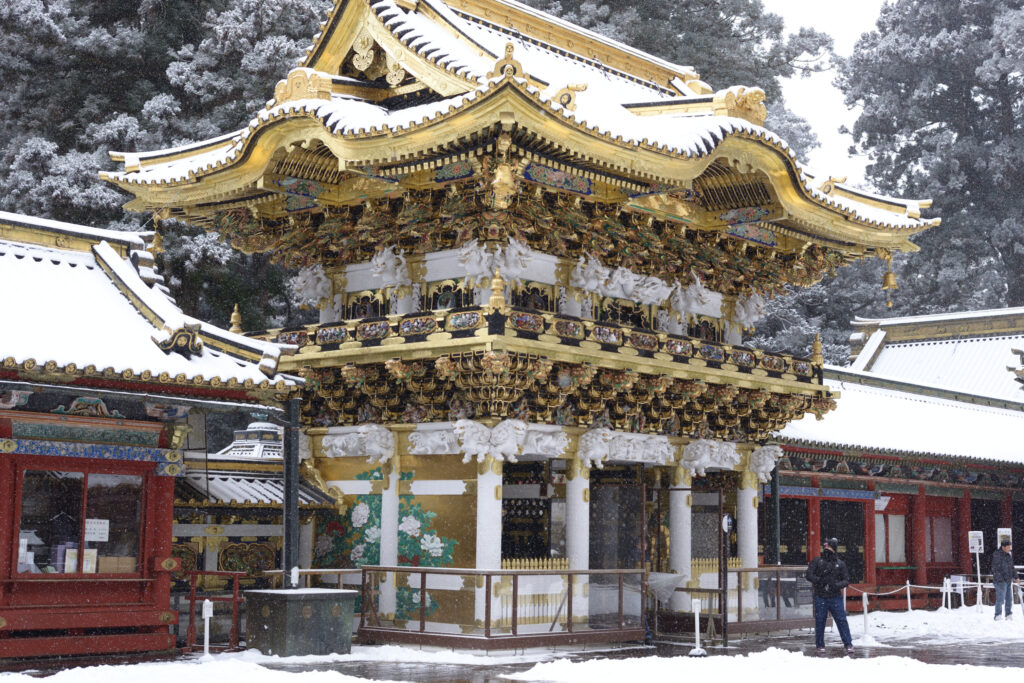
Overview
Yomei-mon is the grand entrance gate to Nikko Toshogu Shrine and is regarded as one of Japan’s most exquisite gates. Also called “Higurashi-no-mon” (Sunset Gate), it is said that its beauty is so mesmerizing that visitors can gaze at it all day without noticing the time pass.
Commissioned in 1636 by Tokugawa Iemitsu, the third shogun, Yomei-mon features over 500 intricately crafted carvings, including dragons, kirin, guardian lions, and phoenixes, which serve as divine protectors of the sacred site. Following extensive restoration efforts from 2013 to 2017, Yomei-mon has regained its original splendor.
| Item | Content |
|---|---|
| Year Built | 1636 (Kan’ei 13) |
| Builder | Tokugawa Iemitsu (3rd Tokugawa Shogun) |
| Structure/Features | Lavishly decorated two-story gate adorned with over 500 intricate carvings of mythical creatures, sages, and floral motifs. Known as “Higurashi-no-mon” (Twilight Gate) due to its captivating beauty that can be admired all day. |
| Renovation/Restoration | Underwent major restoration from 2013 to 2017, including the application of approximately 240,000 sheets of gold leaf to restore its original splendor using traditional techniques. :contentReference[oaicite:1]{index=1} |
| Current Status | Designated as a National Treasure of Japan; open to the public as part of the Nikko Toshogu Shrine complex. |
| Destruction/Damage | None |
| Cultural Property Designation | National Treasure of Japan |
| Remarks | – |
Address: 2301 Yamanouchi, Nikko, Tochigi 321-1431
Walking Time from Three Wise Monkeys: 2 minutes (100m)
⏳ Suggested Visit Time: 20 minutes
Highlights:
- The most iconic gate of Toshogu Shrine, adorned with over 500 intricate carvings.
- Also known as the “Sunset Gate” (Nichiramon), as its beauty captivates visitors for hours.
- The golden embellishments and delicate craftsmanship showcase the peak of Edo-period artistry.
9️⃣ Nemuri-neko (Sleeping Cat) – A Symbol of Peace

Overview
Nemuri-neko (Sleeping Cat) is a small yet highly renowned carving positioned above the entrance to the inner shrine at Nikko Toshogu. Traditionally attributed to the master sculptor Hidari Jingoro (though opinions vary), this delicate artwork holds deep symbolic meaning.
The peacefully sleeping cat is believed to represent a land of tranquility, signifying that the site of Tokugawa Ieyasu’s enshrinement is a place of eternal peace. Behind the Nemuri-neko, a carving of two sparrows can be seen, symbolizing a world so peaceful that even natural enemies—cats and sparrows—can coexist in harmony.
| Item | Content |
|---|---|
| Year Built | Early 17th century (Edo period) |
| Builder | Attributed to Hidari Jingorō |
| Structure/Features | Intricately carved wooden relief of a sleeping cat, surrounded by peonies, located on the East corridor leading to the inner shrine |
| Renovation/Restoration | Restored in 2016 after approximately 60 years; during restoration, the cat’s eyes were depicted slightly open, but later returned to a closed-eye depiction to symbolize peace |
| Current Status | Original carving remains in place; designated as a National Treasure of Japan |
| Destruction/Damage | None |
| Cultural Property Designation | National Treasure of Japan |
| Remarks | – |
Address: 2301 Yamanouchi, Nikko, Tochigi 321-1431
Walking Time from Yomei-mon: 2 minutes (100m)
⏳ Suggested Visit Time: 5 minutes
Highlights:
- A small but famous carving of a sleeping cat, believed to represent peace and tranquility.
- Positioned above a doorway, opposite a carving of sparrows, symbolizing a world without conflict.
- Created by the legendary Edo-period sculptor Hidari Jingorō.
Okumiya Hōtō – The Sacred Mausoleum of Tokugawa Ieyasu
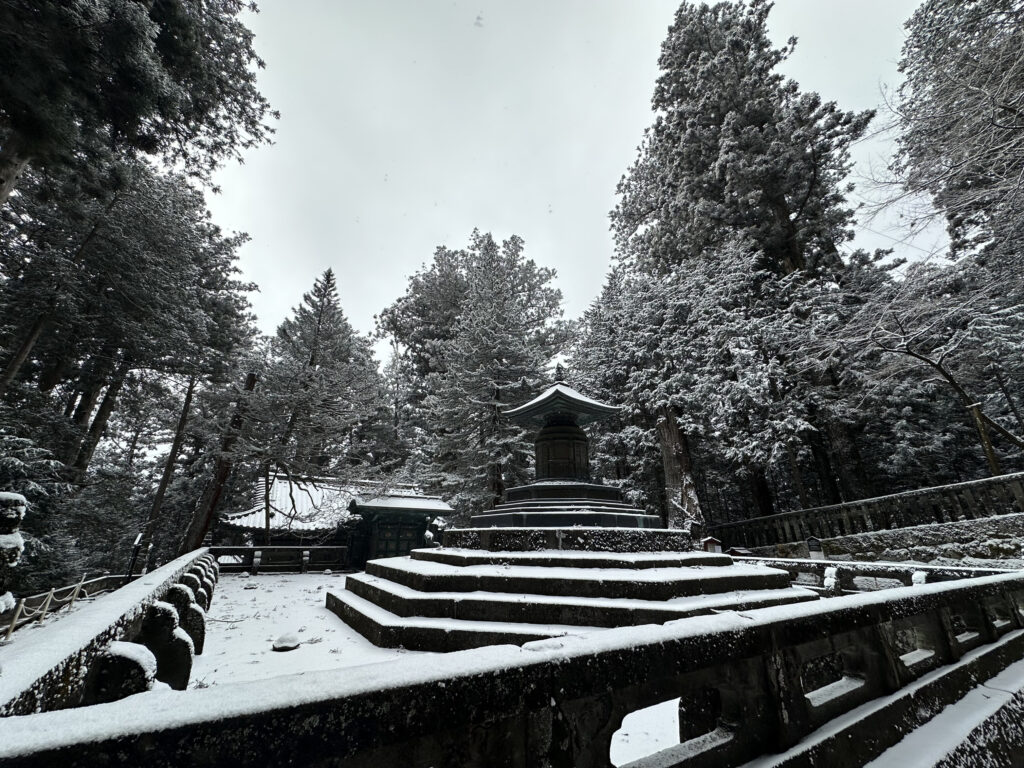
Overview
The Okumiya Pagoda is the most sacred site where the spirit of Tokugawa Ieyasu rests, making it one of the most important areas within the precincts of Nikko Toshogu Shrine. According to Ieyasu’s final wishes, his remains were first interred at Kunozan (Shizuoka Prefecture) upon his passing. However, a year later, in Genna 3 (1617), they were reburied at their current location in Nikko.
The path leading to Okumiya features the famous carving of the “Sleeping Cat” (Nemuri Neko). Beyond this, a stone stairway of 207 steps ascends toward the sacred site. At the top, visitors are greeted by the solemn atmosphere of the entrance gate, Inukimon, which leads to the Pagoda, the final resting place of Tokugawa Ieyasu.
| Item | Content |
|---|---|
| Year Built | 1683 (Tenna 3) |
| Builder | Tokugawa Tsunayoshi (5th Tokugawa Shogun) |
| Structure/Features | 5-meter-high copper pagoda atop an eight-tiered stone base; houses the remains of Tokugawa Ieyasu |
| Renovation/Restoration | Rebuilt in 1683 after an earthquake; original wooden structure from 1621 replaced with copper to enhance durability |
| Current Status | Intact; remains sealed since its construction |
| Destruction/Damage | Original wooden structure destroyed by earthquake prior to 1683 |
| Cultural Property Designation | Part of the Shrines and Temples of Nikkō UNESCO World Heritage Site |
| Remarks | – |
Address: 2301 Yamanouchi, Nikko, Tochigi 321-1431
Walking Time from Nemuri-neko: 10 minutes (500m)
⏳ Suggested Visit Time: 15 minutes
Highlights:
- The final resting place of Tokugawa Ieyasu, situated at the highest point of Toshogu Shrine.
- Accessible via a climb of 207 stone steps, surrounded by towering cedar trees.
- An atmosphere of reverence and tranquility, marking the heart of Toshogu’s spiritual significance.
1️⃣1️⃣ Nikkō Tōshōgū Shrine – Honden & Haiden
Overview
The Main Hall (Honden) and Worship Hall (Haiden) of Nikko Toshogu Shrine serve as the sacred core dedicated to Tokugawa Ieyasu. They are built in the Gongen-zukuri architectural style, one of Japan’s representative shrine designs. The current shrine buildings underwent a major renovation in Kanei 13 (1636) under the command of the third shogun, Tokugawa Iemitsu, featuring elaborate decorations and intricate carvings.
The Main Hall (Honden) is the most sacred space, where the spirit of Ieyasu is enshrined, while the Worship Hall (Haiden) serves as the place where visitors offer their prayers. These halls are connected by a space known as Ishinoma, contributing to the architectural beauty and uniqueness of the structure.
| Item | Content |
|---|---|
| Year Built | 1636 (Kanei 13) |
| Builder | Tokugawa Iemitsu |
| Structure/Features | Gongen-zukuri style: Honden (main sanctuary), Haiden (worship hall), and Ishinoma (stone-floored connecting chamber) |
| Renovation/Restoration | Roofing materials replaced in 1654; stone foundations replaced in 1690 |
| Current Status | Original structure preserved; designated as a National Treasure of Japan |
| Destruction/Damage | – |
| Cultural Property Designation | National Treasure of Japan |
| Remarks | – |
Address: 2301 Yamanouchi, Nikko, Tochigi 321-1431
Walking Time from Okumiya Hōtō: 10 minutes (500m)
⏳ Suggested Visit Time: 30 minutes
Highlights:
- The main shrine complex dedicated to Tokugawa Ieyasu.
- Features opulent architectural details, vibrant colors, and gold-leaf embellishments.
- Recognized as a UNESCO World Heritage Site and a masterpiece of Edo-period craftsmanship.
- Home to the grand spring and autumn festivals featuring the famous Procession of 1,000 Samurai.
1️⃣2️⃣ Rinnoji Yakushido – The Temple of the Healing Buddha
Overview
The Yakushido Hall of Rinno-ji Temple was built as a place of worship to pray for healing and longevity. It enshrines Yakushi Nyorai, the Buddha of Medicine, and has been a site of devotion for centuries within the precincts of Nikko Toshogu Shrine.
One of the hall’s most famous features is its “Naki Ryu” (Crying Dragon) ceiling painting. When visitors clap their hands under the dragon’s mouth, the unique acoustics create an echo that resembles a dragon’s cry, making it a renowned experience.
| Item | Content |
|---|---|
| Year Built | Unknown |
| Builder | Unknown |
| Structure/Features | Traditional wooden hall featuring a ceiling mural of a dragon; known for its unique acoustics producing the “crying dragon” sound when clapped beneath. |
| Renovation/Restoration | Unknown |
| Current Status | Open to the public; visitors can experience the acoustic phenomenon and view the dragon mural. |
| Destruction/Damage | Unknown |
| Cultural Property Designation | Unknown |
| Remarks | – |
Address: 2301 Yamanouchi, Nikko, Tochigi 321-1431
Walking Time from Nikko Toshogu Shrine: 8 minutes (500m)
⏳ Suggested Visit Time: 15 minutes
Highlights:
- A historic temple enshrining Yakushi Nyorai, the Buddha of medicine and healing.
- Famous for its Crying Dragon Ceiling, an artwork that creates a unique echo effect when clapped under.
- A place for health and longevity prayers.
1️⃣3️⃣ Rinnoji Taiyuin – The Mausoleum of Tokugawa Iemitsu
Overview
The Taiyuin Mausoleum of Rinno-ji Temple is the final resting place of Tokugawa Iemitsu, the third shogun of the Edo shogunate. Among the grand temples in the Nikko mountain area, it stands as a particularly magnificent structure.
Out of deep reverence for his grandfather, Tokugawa Ieyasu, who is enshrined at Nikko Toshogu, Iemitsu requested a more modest mausoleum in comparison. Established in Jōō 1 (1652), the Taiyuin Mausoleum is known for its opulent architectural style, adorned with golden embellishments. The Inner Sanctuary (Okunoin) houses Iemitsu’s tomb, making it one of the most prestigious mausoleums among the Tokugawa shoguns.
| Item | Content |
|---|---|
| Year Built | 1653 (Keian 6) |
| Builder | Tokugawa Ietsuna (4th Tokugawa Shogun), fulfilling the will of Tokugawa Iemitsu |
| Structure/Features | Gongen-zukuri style; includes Niōmon, Nitenmon, Yashamon, Kōkamon, and Hōtō; richly decorated with gold and black lacquer |
| Renovation/Restoration | Major restoration completed in 2006; ongoing preservation efforts |
| Current Status | Designated as a National Treasure and part of the UNESCO World Heritage Site “Shrines and Temples of Nikkō” |
| Destruction/Damage | Minor damages from natural aging; no significant destruction recorded |
| Cultural Property Designation | National Treasure of Japan; UNESCO World Heritage Site (1999) |
| Remarks | – |
Address: 2300 Yamanouchi, Nikko, Tochigi 321-1431
Walking Time from Toshogu Shrine: 10 minutes (600m)
⏳ Suggested Visit Time: 30 minutes
Highlights:
- The final resting place of Tokugawa Iemitsu, the third shogun of the Tokugawa dynasty.
- Built in a refined architectural style, featuring black and gold motifs.
- A peaceful contrast to the grandeur of Toshogu Shrine, embodying humility and respect.
1️⃣4️⃣ Kyūokusha Karamon & Kyūokusha Torii – Ancient Remnants of Toshogu’s Predecessor
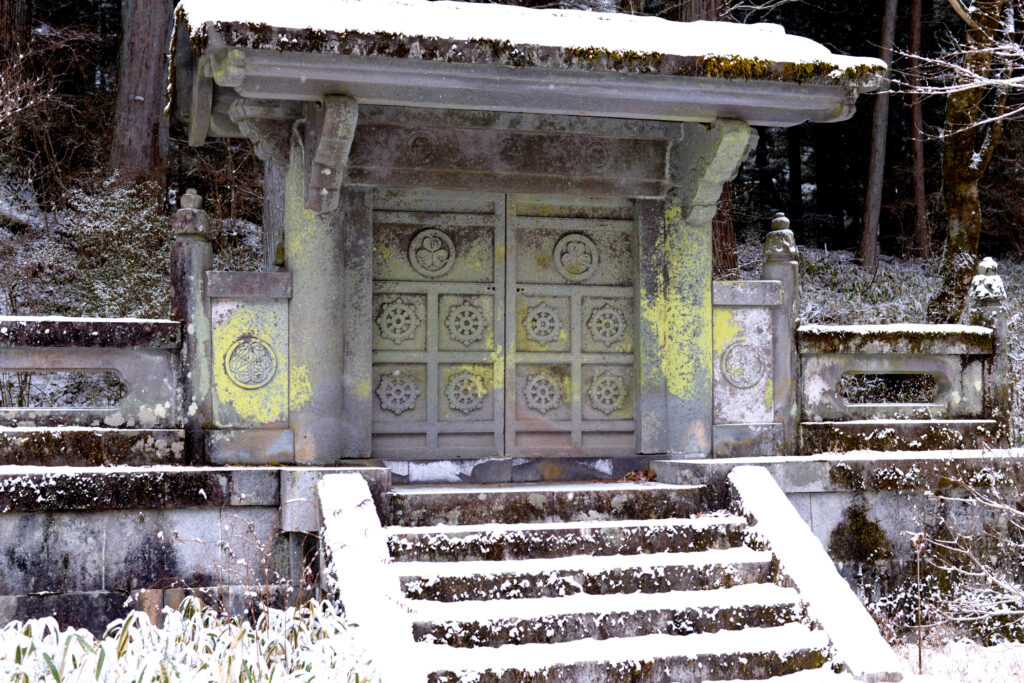
Overview
The Former Okusha Karamon Gate and Torii are historic structures that once belonged to the inner shrine of Nikko Toshogu, where Tokugawa Ieyasu is enshrined.
Originally built from wood in Genna 7 (1622), they were later reconstructed in stone during the Keian era (1648–1652). However, during subsequent renovations, the Karamon Gate and Torii were replaced with bronze structures, and the old ones were buried in the mountains west of the former Okusha shrine.
In Shōwa 42 (1967), these long-lost relics were excavated and restored to their current location, silently preserving the history of their era.
| Item | Content |
|---|---|
| Year Built | 1622 (Genna 8) |
| Builder | Unknown |
| Structure/Features | Originally wooden Karamon gate and Torii gate; later rebuilt in stone during the Keian era |
| Renovation/Restoration | Replaced with bronze structures in later renovations; original stone structures excavated and restored in 1967 (Shōwa 42) |
| Current Status | Restored stone Karamon and Torii stand at relocated site near the shrine |
| Destruction/Damage | Wooden originals replaced; stone versions preserved and later restored |
| Cultural Property Designation | Unknown |
| Remarks | – |
Address: 2300 Yamanouchi, Nikko, Tochigi 321-1431
Walking Time from Taiyuin: 4 minutes (350m)
⏳ Suggested Visit Time: 10 minutes
Highlights:
- The remains of an earlier shrine built before the establishment of Nikko Toshogu.
- Features an ancient stone torii and an old wooden gate, offering a glimpse into the past.
- A quiet and lesser-known historical site, perfect for reflection.
Final Destination: Tobu Nikko Station
Walking Time from Last Stop: 30 minutes (2.3km)
Why End Here?
Returning to the starting point allows you to reflect on the journey while enjoying nearby cafes and souvenir shops.
Step into the past and experience the historical wonders of Nikko! ✨
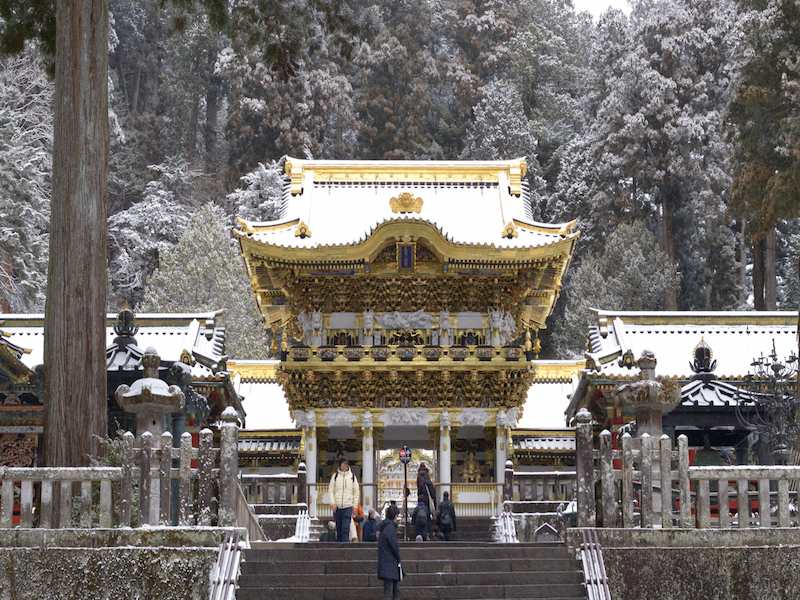

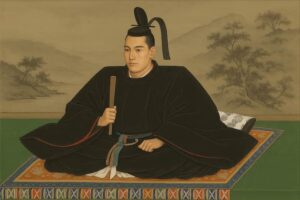
comment